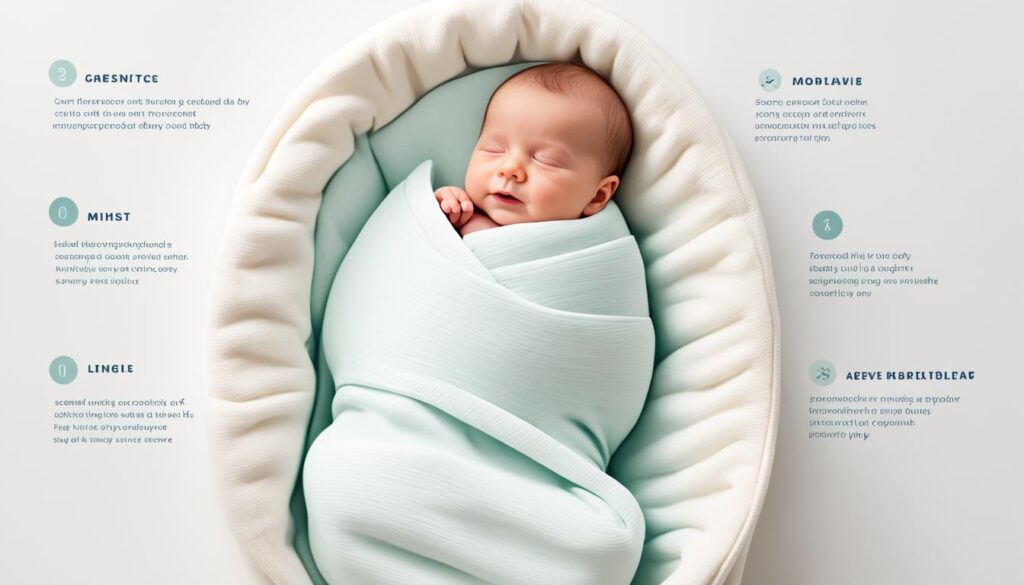Swaddle Timing Guide: How Long To Swaddle Baby
As a new parent, swaddling your baby can provide a comforting and secure environment for better sleep. But when is the right time to stop swaddling? How long should you swaddle your little one? These questions often perplex parents, but fear not, I’m here to guide you through this crucial phase of your baby’s sleep journey.
Key Takeaways:
- Swaddling offers a sense of security and replicates the cozy feeling of the womb.
- The American Academy of Pediatrics recommends stopping swaddling when your baby shows signs of rolling, usually around 3-4 months of age.
- If your baby is within the recommended age range but hasn’t started rolling yet, you can continue swaddling with caution.
- Choosing the right swaddle and observing your baby’s cues are crucial for safe and comfortable sleep.
- There are various methods and strategies for transitioning out of the swaddle when the time comes.
Signs of Rolling and When to Stop Swaddling
As your baby grows and develops, they will reach significant milestones, including the ability to roll over. Recognizing the signs of rolling is crucial in determining when to stop swaddling your little one. Typically, babies start showing signs of rolling between 3-4 months of age.
One of the signs of rolling is when your baby is able to roll from their back to their side. You may notice them shifting their body and making attempts to turn over. Another sign is when your baby starts lifting their body up onto their shoulder, indicating increased strength and mobility.
When your baby exhibits these signs, it is important to discontinue swaddling to ensure their safety during sleep. Rolling over while swaddled can restrict their movement, potentially leading to unsafe sleep conditions. By allowing them to sleep without a swaddle, you enable them to explore their newfound abilities and develop their motor skills.
Remember, not every baby reaches these milestones at the same time. Each little one has their unique pace of development, so keenly observe your baby’s progress and follow their cues when determining the right time to stop swaddling.
| Signs of Rolling | When to Stop Swaddling |
|---|---|
| Rolling from back to side | Discontinue swaddling |
| Lifting body up onto shoulder | Discontinue swaddling |
By paying attention to these signs and making the necessary adjustments to your baby’s sleep routine, you can ensure a safe and comfortable sleep environment as they continue to grow and explore their surroundings.
Reasons for Breaking Out of the Swaddle
Babies are known to break out of their swaddle for various reasons. Understanding these reasons can help you address any concerns and ensure your baby’s comfort and safety during sleep.
- Active Sleep: It is common for newborns to experience active sleep, which is a normal part of their sleep cycle. During this active phase, your baby may move and wiggle, causing them to break out of the swaddle. To prevent this, make sure to use a swaddle that adheres to safety guidelines and keeps your baby secure.
- Overtiredness: When babies are overtired, they may struggle to settle and may fuss or fight the swaddle. This can result in them breaking out of it. To avoid overtiredness, pay attention to your baby’s sleepy cues and establish a consistent sleep routine that allows for enough rest.
- Growth: As babies grow older, they naturally become stronger and more capable of breaking out of the swaddle. Their increased strength and mobility can make it challenging to keep the swaddle secure. To address this, consider using swaddles with velcro or zip designs that provide a more secure fit.
- Type of Swaddle: The type of swaddle you choose can also contribute to your baby breaking out of it. Some swaddles may not be as secure or effective in keeping your baby comfortably wrapped. Explore different swaddle options and find one that works best for your baby’s needs.
By understanding the reasons behind your baby breaking out of the swaddle, you can take the necessary steps to ensure a safe and comfortable sleep environment for your little one.
Swaddling When Baby Rolls to Their Side
Swaddling your baby when they appear to roll to their side is generally safe, especially during the newborn stage. This movement, known as the newborn curl, is a natural reflex that occurs as the baby’s muscles flex involuntarily. It is not an actual sign of rolling and does not indicate that swaddling should be discontinued. In fact, swaddling can actually help newborns sleep safely on their backs by providing a comforting environment that mimics the snugness of the womb.
However, as your baby grows older and gains more strength, they may be able to lift their body up onto their shoulder, which is typically observed around 3-4 months of age according to the AAP. At this stage, rolling onto the side is considered a sign of rolling, and it is time to stop swaddling. Rolling to the side may indicate that your baby is ready to explore different sleep positions, and swaddling can hinder their ability to do so safely.
To ensure your baby’s safety during sleep and to facilitate their motor development, it’s important to discontinue swaddling once they demonstrate the ability to roll onto their shoulder. This allows them to have their arms and hands free for pushing up and repositioning themselves, reducing the risk of suffocation or discomfort during sleep.
Transitioning Out of the Swaddle: Four Options
When it’s time to transition your baby out of the swaddle, there are several options you can consider. Each method offers a different approach to help your little one adjust to sleeping without the swaddle. Let’s explore four popular options:
- Cold Turkey: In this method, you remove the swaddle completely and transition your baby into a sleep sack with their arms free. This abrupt change allows them to experience the freedom of movement while they sleep.
- Swaddle with One Arm Out: This technique involves swaddling your baby with one arm outside of the swaddle. Brands like The Ollie Swaddle offer swaddles with adjustable wings, allowing you to easily achieve this configuration.
- Gradual Transition: With this method, you gradually transition your baby out of the swaddle by starting with one arm out and then progressing to both arms free. This step-by-step approach gives your baby time to adjust and feel comfortable with the changes.
- Partial Night Method: To implement this method, you start the night by allowing one or both arms to be out of the swaddle. As the night progresses, you gradually increase the time your baby spends without the swaddle. This method helps your baby adapt to sleeping without the swaddle while maintaining some level of familiarity.
Aside from these techniques, you can also try implementing a transitional item to provide your baby with a sense of security during the swaddle transition. Items like Swaddle Sleeves or Merlin’s Magic Sleep Suit can offer the comfort and coziness your baby is accustomed to while gradually weaning them off the swaddle.
It’s important to remember that every baby is unique, so choose the method that works best for your little one’s needs. Observe their response and adapt accordingly to ensure a smooth and successful transition out of the swaddle.
Strategies for Transitioning Out of the Swaddle

Transitioning out of the swaddle can be a challenging milestone for both babies and parents. However, with the right strategies and approaches, this transition can be made smoother and more successful. One of the key factors to consider when transitioning out of the swaddle is your baby’s age. Here are some strategies to help you navigate this transition based on your baby’s age:
For Babies Under 5 Months:
If your baby is under 5 months and you’re considering transitioning them out of the swaddle, here are some strategies to try:
- Start by gradually loosening the swaddle or leaving one arm out while keeping the rest of the body swaddled. This can help your baby get used to the feeling of having their arms free without completely eliminating the swaddle.
- Introduce a transitional item, such as a sleep sack or swaddle-sleep-sack hybrid, to provide a sense of security and mimic the snugness of a swaddle while allowing more freedom of movement.
- Create a calming bedtime routine that incorporates soothing activities like a warm bath, gentle massage, or soft lullabies. These activities can help signal to your baby that it’s time to relax and prepare for sleep.
For Babies Over 5 Months:
If your baby is over 5 months and still struggling with sleep after transitioning out of the swaddle, following a holistic sleep plan like the 5-24 Month Collection may be beneficial. This collection provides a step-by-step guide for establishing consolidated sleep patterns and addressing specific sleep challenges based on your baby’s age.
Regardless of your baby’s age, it’s important to create a calming bedtime routine and establish a soothing sleep environment. This can be achieved by dimming the lights, playing soft white noise or calming music, and using blackout curtains to create a dark and serene atmosphere.
Quotes:
“Transitioning out of the swaddle can be a significant change for babies, but with the right strategies and a little patience, it can be a smooth process.” – Dr. Emily Johnson, Pediatric Sleep Specialist
Different Strategies for Transitioning Out of the Swaddle
| Strategy | Description |
|---|---|
| Cold Turkey Method | Moving your baby into a sleep sack with their arms free without using any swaddle. |
| Swaddling with One Arm Out | Gradually transitioning your baby by starting with one arm out while keeping the rest of the body swaddled, then moving to both arms out. |
| Partial Night Method | Starting the night with one or both arms out of the swaddle and gradually increasing the time with arms free throughout the night. |
| Implementing a Transitional Item | Using sleep sacks or swaddle-sleep-sack hybrids to provide a sense of security while allowing your baby to transition out of the swaddle. |
When to Seek Help for Swaddle Transition
If you are finding it difficult to transition your baby out of the swaddle and experiencing sleep disruptions, don’t worry – you’re not alone. It’s normal to encounter challenges during this process, and seeking help can make a world of difference.
One resource that can provide guidance and strategies for navigating the swaddle transition is Taking Cara Babies classes. These classes offer customized plans based on your baby’s age and specific needs, ensuring a smoother transition and better sleep for both you and your little one.
Another option is to consult a qualified sleep consultant or pediatrician who specializes in infant sleep. They can offer expert advice tailored to your baby’s unique situation and help troubleshoot any difficulties you may be facing. Seeking professional help can provide valuable insights and support during this transitional phase.
Remember, every baby is different, and what works for one may not work for another. It’s important to be patient and kind to yourself as you navigate the swaddle transition – it may take time, but with the right support, you and your baby can conquer this milestone and enjoy restful nights once again.
Safety Guidelines for Swaddling

When swaddling your baby, it is crucial to prioritize their safety. By following these guidelines, you can ensure a safe and comfortable sleep environment:
- Always place your baby on their back: When it’s time for sleep, lay your baby on a firm and flat surface on their back. This helps reduce the risk of Sudden Infant Death Syndrome (SIDS).
- Avoid loose bedding and soft objects: Remove any loose blankets, pillows, stuffed toys, or other soft objects from the sleep area. These can pose suffocation hazards.
- Choose lightweight swaddle blankets or secure zipper swaddles: Opt for swaddles that are designed to be lightweight and breathable. Make sure they are snug around the torso and arms but looser around the hips and legs to allow for natural leg movement.
- Avoid weighted swaddles: Weighted swaddles can put excessive pressure on your baby’s chest and lungs, so it’s best to avoid them. Stick to swaddles that provide a secure yet comfortable fit.
- Ensure proper sizing: Select the appropriate size of swaddle based on your baby’s height and weight. Swaddles that are too small can be uncomfortable, while those that are too big may unravel easily.
Adhering to these swaddle safety guidelines will help create a safe sleep environment for your baby, promoting a restful and secure slumber.
Best Practices for Safe Swaddling
“Swaddling can offer comfort and security for your baby, but it’s important to ensure their safety by following these best practices.”
Swaddling is an effective technique for soothing and comforting babies. However, it’s crucial to swaddle your baby safely to reduce the risk of sleep-related accidents or injuries. By following the safety guidelines mentioned above and practicing safe swaddling techniques, you can provide your baby with a secure and peaceful sleep environment.
The Benefits of Swaddling
Swaddling offers several benefits for babies, including calming them and helping them sleep better. By recreating the sensation of being in the womb, swaddling provides a sense of security and comfort for newborns.
- Calming Infants: Swaddling helps babies feel safe and secure by limiting their movements and reducing the startle reflex. This can soothe fussy babies and create a calming environment for sleep.
- Better Sleep: The snugness of the swaddle can make babies feel cozy, replicating the feeling of being in the womb. This can result in longer and more restful sleep for both babies and parents.
Swaddling also helps regulate a baby’s body temperature and prevents them from flailing their arms and legs, which can lead to disruptions in sleep. To fully understand the benefits of swaddling, let’s take a look at a comparative table:
| Benefits of Swaddling | Calming Infants | Better Sleep |
|---|---|---|
| Creates a sense of security and comfort | Reduces the startle reflex | Replicates the cozy feeling of the womb |
| Helps soothe fussy babies | Allows for longer and more restful sleep | Prevents flailing of arms and legs |
| Regulates body temperature |
In the words of a satisfied parent:
“Swaddling has been a game-changer for us. Our baby used to have difficulty settling down for sleep, but ever since we started swaddling, he has been more calm and sleeps for longer stretches. It’s been a blessing!” – Jessica, mother of a 2-month-old
Swaddling is a simple yet effective technique that can have a positive impact on your baby’s sleep. Whether you choose to use a traditional swaddle blanket or a specially designed swaddle with secure fastenings, the benefits of swaddling are undeniable. Keep in mind that every baby is different, so it’s essential to observe your little one’s cues and adapt your approach to provide the most comfortable and safe sleep environment.
Swaddling Considerations for Different Ages
When it comes to swaddling your baby, it’s essential to consider their age and developmental stage. Swaddling provides a cozy and secure environment for newborns, simulating the feeling of being in the womb and promoting better sleep. However, as babies grow older and reach certain milestones, swaddling needs to be adjusted or discontinued to ensure their safety and comfort.
As a general guideline, it is recommended to stop swaddling when your baby starts showing signs of rolling, usually around 3-4 months of age. Rolling is an important milestone that indicates their growing strength and mobility. Swaddling can restrict their movement and pose a potential risk, so it’s crucial to discontinue swaddling at this stage.
To make an informed decision about swaddling for your baby, it’s important to constantly assess their development and adjust your practices accordingly. Every baby is different, and their readiness to transition out of swaddling may vary. Keep a close eye on their motor skills and observe for signs of rolling or attempting to break free from the swaddle.
Using the SNOO Smart Sleeper for Safe Swaddling
If you’re looking for a safe and effective way to continue swaddling beyond the 3-4 month mark, the SNOO Smart Sleeper can be a great option. This innovative sleep solution is designed to promote safe sleep and prevent rolling while allowing for secure swaddling up to 6 months of age.
| Age | Swaddling Considerations |
|---|---|
| Newborn (0-3 months) | Swaddling is beneficial as it replicates the coziness of the womb and helps promote better sleep. |
| 3-4 months | Monitor your baby for signs of rolling. Discontinue swaddling once they start showing these signs to ensure their safety during sleep. |
| 4-6 months | Transition your baby out of swaddling by gradually introducing arms-free sleep or using alternative sleep aids like sleep sacks or wearable blankets. |
By considering your baby’s age, milestones, and using appropriate sleep aids, you can ensure a smooth and safe transition out of swaddling while maintaining optimal sleep for your little one.
Tips for Helping Baby Sleep Without Swaddle
If your baby has transitioned out of the swaddle, there are several tips and sleep aids that can help them sleep without it. Establishing a calming bedtime routine is key. Start with a warm bath followed by a feeding session, gentle rocking, and a soothing lullaby or story to help your baby unwind and prepare for sleep.
Creating a soothing ambiance in the nursery can also promote better sleep. Use dim lighting, soft sounds, or a white noise machine to create a peaceful environment. These elements can help your baby feel more relaxed and comfortable throughout the night.
Additionally, using sleep aids like wearable blankets or sleep sacks can provide a sense of security and mimic the snugness of a swaddle. These options allow your baby to feel cozy while still having the freedom to move their arms and legs. Massage and touch can also be comforting for babies, so consider incorporating gentle strokes or baby massage techniques into your bedtime routine.
Remember, every baby is unique, so it may take some trial and error to find the sleep aids and strategies that work best for your little one. By experimenting with different approaches and staying consistent with your calming bedtime routine, you can help your baby sleep soundly without the need for a swaddle.
FAQ
How long should I swaddle my baby?
The general recommendation is to stop swaddling when your baby starts showing signs of rolling, which usually occurs around 3-4 months of age.
What are the signs that my baby is ready to stop swaddling?
Signs that your baby is ready to stop swaddling include being able to roll from their back to their side or lifting their body up onto their shoulder.
Why does my baby break out of the swaddle?
Babies may break out of the swaddle due to active sleep, overtiredness, or increased strength as they grow older. It’s important to use a swaddle that adheres to safety guidelines and find the right type of swaddle that works best for your baby.
Is it safe to swaddle my baby if they roll to their side?
Swaddling when a newborn appears to roll to their side is usually safe, as it is often a result of an involuntary muscle flexion called the newborn curl. However, once your baby is able to get their body up onto their shoulder, typically seen between 3-4 months, it is time to stop swaddling.
What are the options for transitioning my baby out of the swaddle?
There are four options for transitioning your baby out of the swaddle: the cold turkey method, swaddling with one arm out, gradually transitioning with both arms out, and implementing a transitional item such as Swaddle Sleeves or Merlin’s Magic Sleep Suit.
How can I help my baby transition out of the swaddle?
To help your baby transition out of the swaddle, you can establish a calming bedtime routine, create a soothing ambiance, incorporate touch through infant massage, and use sleep aids like wearable blankets or sleep sacks.
When should I seek help for the swaddle transition?
If you are struggling with the transition out of the swaddle and experiencing sleep disruptions, it may be helpful to seek professional help. Taking Cara Babies classes offer guidance and strategies for navigating the swaddle transition and other sleep-related challenges.
What are the safety guidelines for swaddling?
When swaddling your baby, ensure they are placed on their back to sleep on a firm, flat surface without any loose bedding or soft objects. Use lightweight swaddle blankets or secure zipper swaddles that are snug around the torso and arms but looser around the hips and legs. Avoid using weighted swaddles and ensure proper sizing of the swaddle based on your baby’s height and weight.
What are the benefits of swaddling?
Swaddling offers several benefits for babies, including calming them and helping them sleep better. It replicates the cozy feeling of the womb, prevents the startle reflex, regulates body temperature, and reduces flailing of arms and legs during sleep.
What should I consider when swaddling my baby of different ages?
Swaddling should be considered based on the age and developmental stage of your baby. Newborns benefit from swaddling as it replicates the coziness of the womb. As babies grow older and start showing signs of rolling, swaddling becomes less safe and should be discontinued.
How can I help my baby sleep without the swaddle?
To help your baby sleep without the swaddle, establish a calming bedtime routine, create a soothing ambiance, use sleep aids like wearable blankets or sleep sacks, and consider implementing touch through massage.










